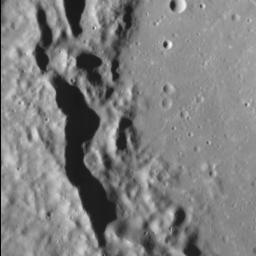Originally released on Oct. 16, 2013
Named for the Roman poet Gaius Valerius Catullus, this impact crater, 100 km (62 mi.) in diameter, has a smoothly textured floor like that seen elsewhere on Mercury. The western portion of the floor (right) abuts against the inner, terraced wall of the crater (middle), which is bordered by the surrounding, older terrain (left). Scientists know of two ways to render the floor of a crater smooth: impact melt or volcanism. It can be difficult to differentiate the two processes, however, and so the nature of the smooth material within Catullus remains unknown. However, in a larger view a depression can be seen in the center of Catullus that may be volcanic in nature -- and so too might the floor of the crater itself.
This image was acquired as a high-resolution targeted observation. Targeted observations are images of a small area on Mercury's surface at resolutions much higher than the 200-meter/pixel morphology base map. It is not possible to cover all of Mercury's surface at this high resolution, but typically several areas of high scientific interest are imaged in this mode each week.
Date acquired: August 8, 2013
Image Mission Elapsed Time (MET): 18306428
Image ID: 4595268
Instrument: Narrow Angle Camera (NAC) of the Mercury Dual Imaging System (MDIS)
Center Latitude: 21.98°
Center Longitude: 293.43° E
Resolution: 39 meters/pixel
Scale: The field of view in this image is approx. 40 km (25 mi.) across
Incidence Angle: 68.1°
Emission Angle: 3.5°
Phase Angle: 71.6°
North is down in this image.
The MESSENGER spacecraft is the first ever to orbit the planet Mercury, and the spacecraft's seven scientific instruments and radio science investigation are unraveling the history and evolution of the Solar System's innermost planet. MESSENGER acquired over 150,000 images and extensive other data sets. MESSENGER is capable of continuing orbital operations until early 2015.
For information regarding the use of images, see the MESSENGER image use policy.

 Planetary Data System
Planetary Data System












